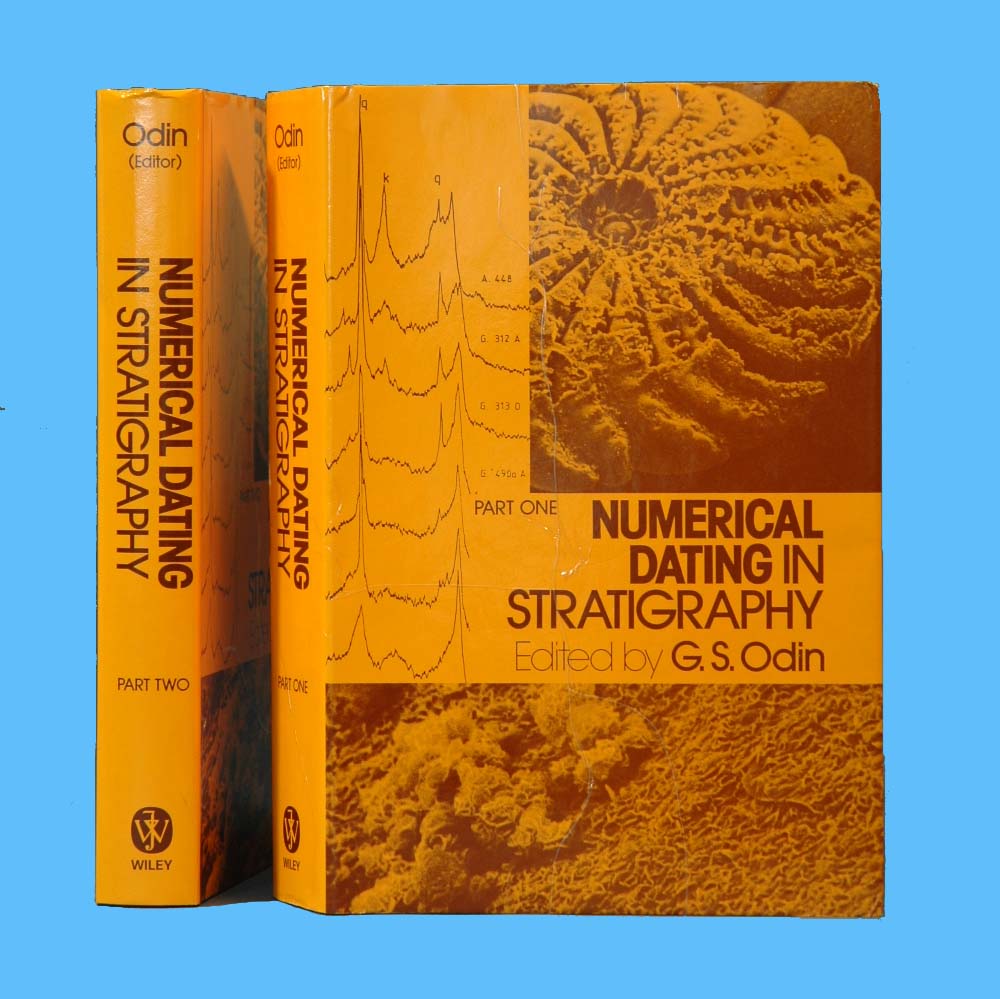 |
|
|
Odin,
G.S. (rédacteur), 1982. Numerical dating in Stratigraphy (ISBN
0 471 90022 2; 822 exemplaires, épuisé) |
|
Ce
travail, réalisé avec la collaboration de 137 confrères,
a eu pour objectif de revoir l'échelle des temps établie
en 1964 à la lumière, notamment, de 251 études ponctuelles
résumées dans le vol. II. Une attention particulière
a été apportée à l'identification et à
l'estimation des incertitudes
|
|
PARTIE
I METHODOLOGY
|
1-
|
Uncertainties
in evaluationg the numerical time scale G.S. Odin |
3
|
|
Section
I: Methods of correlation
|
||
|
2-
|
Biochronology
- Biological events in time resolution, their potential and limitations
B. U. Haq & T.R. Worsley |
19
|
|
3-
|
Geochemical
events as a means of correlation G. S. Odin, M. Renard & C. Vergnaud Grazzini |
37
|
|
4-
|
The
marine strontium geochronometer G. Faure |
73
|
|
5-
|
Palaeomagnetic
stratigraphy as a correlation technique J. E. T. Channel |
81
|
|
Section
II: Isotopic dating
|
||
|
6-
|
The
physical decay constants N. Gale |
107
|
|
7-
|
Interlaboratory
standards for dating purposes G. S. Odin and 35 collaborators |
123
|
|
|
Appendix:
An example of interlaboratory reproductibility for Glauconite GL-O W. Harre & H. Kreuzer |
149
|
|
8-
|
Potassium-argon
analysis M. Flisch |
151
|
|
9-
|
Range
and effectiveness of unspiked potassium-argon dating C. Cassignol & P.-Y. Gillot |
159
|
|
10-
|
The
39Ar/40Ar technique of dating F. Albarède |
181
|
|
11-
|
The
application of fission track dating to stratigraphy: critical review D. Storzer & G. Wagner |
199
|
|
Section
III: Utilization of sediments as geochronometers
|
||
|
12-
|
A comparison
of rubidium-strontium and potassium-argon apparent ages of glauconies
E. Keppens & P Pasteels |
225
|
|
|
Appendix:
Analytical feasibility of rubidium-strontium dating of young glauconies
E. Keppens |
240
|
|
13-
|
The rubidium-strintium
method applied to sediments: certitudes and uncertainties N. Clauer |
245
|
|
14-
|
Zero
isotopic age of glauconies G. S. Odin & M. Dodson |
277
|
|
15-
|
Effect
of pressure and temperature on clay mineral potassium-argon ages G. S. Odin |
307
|
|
16-
|
Potassium-argon
dating of tectonized glauconies M. Conard, H. Kreuzer & G. S. Odin |
321
|
|
17-
|
Argon
behaviour in clays and glauconies during preheating experiments G. S. Odin & M. Bonhomme |
333
|
|
18-
|
Kinetics
of the release of argon and fluids from glauconies J. L. Zimmermann & G. S. Odin |
345
|
|
19-
|
Potassium-argon
dating of washed, leached, weathered, and reworked gkauconies G. S. Odin & D. C. Rex |
363
|
|
20-
|
How
to measure glaucony ages G. S. Odin |
387
|
|
Section
IV: Utilization of high temperature rocks as geochronometers
|
||
|
21-
|
The
genesis of bentonites A. F. Person |
407
|
|
22-
|
The
dating of bentonite beds H. Baadsgaard & J. F. Lerbekmo |
423
|
|
23-
|
The
dating of plutonic events N. H. Gale |
441
|
PARTIE II CALIBRATING THE TIME SCALE
|
Section
V: The Cambrian to Triassic times
|
||
|
24-
|
The
data from Scotland and the Carboniferous time scale H. A. F. de Souza |
455
|
|
25-
|
Numerical
dating of Caledonian times (Cambrian to Silurian) N. H. Gale |
467
|
|
26-
|
Numerical
dating of Hercynian times (Devonian to Permian) G. S. Odin & N. H. Gale |
487
|
|
27-
|
A calibration
point in the Late Triassic: the tin granites of Bangka, Indonesia H. N. A. Priem & E. H. Bon |
501
|
|
28-
|
Late
Triassic-Early Jurassic time-cscale calibration in British Columbia, Canbada
R. L. Armstrong |
509
|
|
29-
|
Triassic
radiometric dates from eastern Australia J. A. Webb |
515
|
|
30-
|
The Triassic time scale in 1981 G. S. Odin & R. Létolle |
523
|
|
Section
VI: The Jurassic to Palaeogene times
|
||
|
31-
|
Radiometric
dating of the Albian-Cenomanian boundary G. S. Odin & J. C. Hunziker |
537
|
|
32-
|
The
Jurassic and Cretaceous time scale in 1981 W. J Kennedy & G. S. Odin |
557
|
|
33-
|
Rubidium-strontium
glaucony ages, SE Atlantic Coastal Plain, USA W. B. Harris |
593
|
|
34-
|
Dating
of the Palaeogene D. Curry & G. S. Odin |
607
|
PARTIE III ABSTRACTS FOR A REVISION OF THE PHANEROZOIC TIME SCALE
|
35-
|
Introduction:
Individual radiometric studies of stratigraphically calibrated samples
G. S. Odin |
633
|
|
|
Résumés NDS 001 à NDS 251 auteurs divers |
659
|
|
36-
|
Potassium-argon
calculation using conventional constants R. Siegenthaler |
949
|
|
37-
|
The Phanerozoic
time scale in 1981 G. S. Odin, D. Curry, N. H. Gale & W. J. Kennedy |
957
|
|
|
Références |
961
|
|
|
Index |
1005
|
